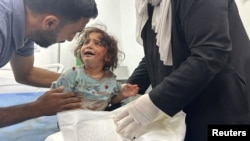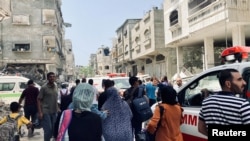U.N. officials warn medicine and fuel supplies in Gaza are drying up as humanitarian workers struggle to provide life-saving care to an ever-expanding population of sick and wounded.
“The medical supplies and fuel supplies are running very, very low,” World Health Organization spokesperson Dr. Margaret Harris told journalists Tuesday in Geneva.
She said only three WHO trucks carrying aid have entered the besieged city of Rafah since the Israeli incursion began there in early May.
“We have 60 WHO supply trucks waiting at al-Arish unable to cross into Rafah due to the closure of the border,” she said.
“Fuel is particularly critical,” she said, noting that an estimated 200,000 liters a day are needed to run the 14 officially functioning hospitals in Gaza. “We have been able to get in 60,000 liters per day at best. Some days none. So, all the hospitals are really struggling and making decisions about what they can do … particularly in Rafah where only Emirati hospital remains barely functional.”
This means that key health services are no longer available in Rafah, including dialysis, surgery, and maternity care, she said.
UNICEF spokesperson James Elder said because of the lack of fuel, the desalination plants in Central and Southern Gaza have been shut for at least eight hours every day, dramatically shrinking the water supply.
“On average, in Rafah, a person is getting around one liter of water a day, which is catastrophically below any emergency level,” he said. The WHO says people need a minimum of 15 liters per person per day to cover hydration and sanitation-related needs.
Israel has faced heavy international pressure to step up the flow of aid into Gaza, where relief groups have warned of a severe humanitarian crisis threatening a population of more than 2 million people.
Israel has repeatedly denied allegations that it is preventing aid from reaching the territory and accused U.N. aid agencies of failing to properly distribute the relief supplies that get in. However, Israeli protesters have been captured on video blocking aid trucks and throwing supplies from the trucks onto the ground.
According to the Hamas-run health ministry in Gaza, at least 45 people sheltering in a camp for displaced Palestinians were killed in an Israeli airstrike Sunday. Since October 7 when Israel began its invasion of Gaza in response to a brutal attack on Israel by Hamas militants, Gaza’s health ministry reports more than 36,000 Palestinians have been killed and over 81,000 injured.
Amid all this death and destruction, WHO spokesperson Harris said “one little bright spot” in Gaza is the return of dialysis services in Nassar General hospital and the reported return of similar services soon in al-Shifa hospital.
“It is extraordinary how despite the massive destruction and the difficult circumstances people are working under, is that the people keep on coming back and restoring services as best they can to keep on serving the people,” she said.
Dr. Akihiri Seita, director of health for the U.N. Relief and Works Agency for Palestine Refugees, echoed this sentiment.
“I am very proud to say that UNRWA never stopped health services,” he said. “We continue to provide services and they include vaccinations. We started vaccinations from the beginning of the year and so far, we have 100,000 children vaccinated. So, it is quite a good catch-up to the pre-war level.”
“We provide primary health care. At this point we have seven health centers and 105 medical points that are all in the shelters. … Every day, we treat 15,000 to 20,000 people, and sometimes 25,000,” he said.
However, this comes at a heavy cost. UNRWA’s Department of Health Annual Report 2023, issued Tuesday, notes that as of April 2024, “UNRWA has lost over 188 staff members including 11 health care professionals.”
In the last three months of 2023, the report says medical consultations in Gaza dropped rapidly as UNRWA was forced to close 14 of its 22 health centers and power outages shuttered access to telehealth systems.
“Not only did access to basic healthcare become near impossible, but the hostilities also created dozens of new health catastrophes, with mounting war injuries, internal displacement, mental health crises, the destruction of sanitation infrastructure, and the probable conditions for epidemic and famine,” the report said.
Seita said UNRWA has had great difficulty providing health and other humanitarian aid to Palestinians in Gaza since 16 countries suspended financial aid early in the year due to Israeli allegations that the organization was harboring Hamas terrorists.
While 14 countries have since resumed financial aid, he said hardships in providing aid persist because “we have still not yet reached the sustainable financing level.”
That sentiment was echoed by WHO’s Margaret Harris, who described the enormous struggle for all the medical teams in Gaza who are unable to meet the needs of the critically ill and wounded.
“This is one of the hardest things for a doctor or a nurse. You know you want to help but you do not have what it takes, and you are watching people who should not die, die in front of you because you simply either lack the tools, the skill, or the supplies to do what need to be done,” she said.










